Abstract
Vascular smooth muscle cells (VSMCs) under biophysical stress play an active role in the progression of vascular inflammation, but the precise mechanisms are unclear. This study examined the cellular expression of monocyte chemoattractant protein 1 (MCP-1) and its related mechanisms using cultured rat aortic VSMCs stimulated with mechanical stretch (MS, equibiaxial cyclic stretch, 60 cycles/min). When the cells were stimulated with 10% MS, MCP-1 expression was markedly increased compared to those in the cells stimulated with low MS intensity (3% or 5%). An enzyme-linked immunosorbent assay revealed an increase in HMGB1 released into culture media from the cells stimulated with 10% MS compared to those stimulated with 3% MS. A pretreatment with glycyrrhizin, a HMGB1 inhibitor, resulted in the marked attenuation of MCP-1 expression in the cells stimulated with 10% MS, suggesting a key role of HMGB1 on MCP-1 expression. Western blot analysis revealed higher PDGFR-α and PDGFR-β expression in the cells stimulated with 10% MS than 3% MS-stimulated cells. In the cells deficient of PDGFR-β using siRNA, but not PDGFR-α, HMGB1 released into culture media was significantly attenuated in the 10% MS-stimulated cells. Similarly, MCP-1 expression induced in 10% MS-stimulated cells was also attenuated in cells deficient of PDGFR-β. Overall, the PDGFR-β signaling plays a pivotal role in the increased expression of MCP-1 in VSMCs stressed with 10% MS. Therefore, targeting PDGFR-β signaling in VSMCs might be a promising therapeutic strategy for vascular complications in the vasculatures under excessive biophysical stress.
The vessel wall is continuously exposed to biomechanical stressors that elicit functional and adaptative responses. Among multiple cells in the blood vessel walls, vascular smooth muscle cells (VSMCs) are critical cells involved in vascular remodeling in the injured vasculatures [1]. VSMCs show proliferative and migratory activities in response to physiological stress or pathological insults such as inflammation and hypertension [2,3]. When blood pressure increases, the physical force continually exposes the blood vessel walls to mechanical stretch (MS) [4].
In the process of vascular remodeling, VSMCs in the media move into the intima and then proliferate in response to various mediators secreted by inflammatory cells [5,6]. In atherosclerotic plaques, high levels of high mobility group box 1 (HMGB1) are detected, which are suggested to be a major mediator involved in vascular inflammation [7,8]. The contractile phenotype of VSMCs in the normal vasculatures switches to the synthetic phenotype in vascular inflammation [9,10], leading VSMCs to migrate from the media to the intima, ultimately causing intimal hyperplasia and vascular restenosis [11]. Although HMGB1 was suggested to be a major contributor to the development of proliferative vascular diseases through the phenotypic conversion of VSMCs [12,13], the precise role and molecular action mechanisms of HMGB1 are still unclear.
Inflammatory cytokines, such as monocyte chemoattractant protein 1 (MCP-1), play a vital role in the infiltration of monocytes into the vessel wall in the injured vasculatures. MCP-1 recruits various inflammatory cells including monocytes to the inflammation sites, indicating its importance in mediating neointima formation and vascular inflammation [14]. Although MCP-1 has been indicated as a major molecule in the initiation and progression of the vascular inflammatory process, the major cellular source and molecular mechanisms responsible for MCP-1 expression in VSMCs are unclear.
VSMCs under biophysical stress play an active role in vascular inflammation and remodeling, but the precise mechanisms are unclear. Therefore, this study investigated MCP-1 expression and its related mechanisms using VSMCs stressed with high intensity (10%) MS (equibiaxial cyclic stretch, 60 cycles/min). In addition, to investigate the individual importance of PDGFR isoforms on vascular remodeling in the vasculatures under excessive biophysical stress, this study identified the links between MCP-1 expression and PDGFR signaling in VSMCs stimulated with 10% MS.
All animal procedures were complied with the Guide for the Care and Use of Laboratory Animals published by the United States National Institutes of Health (NIH Publication No.85-23, 2011 revision). The Pusan National University Institutional Animal Care and Use Committee approved all experimental protocols (PNU-2021-2965). Sprague-Dawley (SD) rats were purchased from Charles River Breeding Laboratories.
MCP-1 (PA5-34505) antibodies were purchased from Invitrogen. Glycyrrhizin (3-O-(2-O-β-D-Glucopyranuronosyl-α-D-glucopyranuronosyl)-18β-glycyrrhetinic acid) was obtained from Sigma-Aldrich Inc. β-Actin (sc-47778) antibody was acquired from Santa Cruz Biotechnology Inc. The PDGFR-α (3164S) and PDGFR-β (3169S) antibodies were supplied by Cell Signaling Technology. The secondary antibody used horseradish peroxidase (HRP)-conjugated IgG antibody obtained from Santa Cruz Biotechnology Inc.
Male SD rats (seven weeks old) were euthanized by CO2 inhalation, and then dissected to isolate the thoracic aorta. The resected aortas were cut and transplanted into a cell culture dish containing Dulbecco’s Modified Eagle’s Medium (DMEM, Gibco BRL) supplemented with 10% fetal bovine serum (FBS, Gibco BRL). The cells were then maintained at 37°C in DMEM with 10% FBS and an antibiotic-antimycotic solution (Gibco BRL).
The VSMCs cultured from the rat thoracic aorta were seeded onto flexible-bottomed 6-well BioFlex culture plates (BF-3001C; Dunn Labortechnik) and incubated in CO2 incubator at 37°C, 95% humidity and 5% CO2 for 24 h. A Flexcell Tension Plus FX-4000T system (Flexcell International Corp.) was used to exert physiological equibiaxial cyclic stretch (1 Hz, 0%–10% strain, 60 cycles/min) for 0 to 12 h.
Ice-cold lysis buffer (Thermo Fisher Scientific) was used to collect and prepare the VSMC lysates. The same amounts of protein were separated on 10%–12% polyacrylamide gels under reducing conditions, and then transferred to nitrocellulose membranes (Amersham-Pharmacia Biotech). The membranes were blocked with 5% skim milk in Tris-buffered saline with Tween-20 (TBST) for 2 h at room temperature. The membranes were then incubated overnight with the primary antibodies in 5% skim milk at 4°C. TBST was used to wash the membranes, and then incubated with HRP-conjugated secondary antibody for 2 h at room temperature. The blots were developed using the enhanced chemiluminescence Western blotting detection reagents (Amersham-Pharmacia Biotech), and images of the blots were captured using image capturing software (Amersham, Imager 680 version. 2.0.). The signal bands were quantified using the UNSCAN-IT CEL 7.1 program. The membranes were reblotted with anti-β-actin antibody as an internal control.
Rat aortic VSMCs seeded onto flexible-bottomed 6-well BioFlex culture plates were stimulated by MS, and the HMGB1 released into culture media was measured using a rat HMGB-1 ELISA kit (Elabscience Biotechnology Inc) according to the manufacturer’s instructions.
PDGFR-α and PDGFR-β siRNA oligonucleotides were synthesized at Bioneer to prepare cells deficient of PDGFR isoforms. The siRNA negative control duplex was used as a control. To transfect all the siRNA molecules, lipofectamine 2000 (Invitrogen) was used. Briefly, VSMCs were seeded on 6-well plates and grown for 24 h before siRNA transfection. After replacing the culture medium with Optimized-Minimal Essential Medium (Opti-MEM, Gibco BRL), the cells were transfected with siRNAs for PDGFR-α, PDGFR-β and negative control using Lipofectamine 2000 and then incubated for 6 h at 37°C. The Opti-MEM was then replaced with DMEM, and the cells were incubated at 37°C for 24 h.
The effects of MS on MCP-1 expression in VSMCs were identified by stimulating cultured rat aortic VSMCs seeded onto BioFlex 6-well culture plates with 0, 3, 5 and 10% MS for 12 h. As shown in Fig. 1A, MCP-1 expression in cells stimulated with 10% MS was markedly increased compared to those in the cells stimulated with 3% or 5% MS. The MCP-1 expression in 10% MS-stimulated cells was increased at 6 h of stimulation, and increased further up to 12 h of MS stimulation (Fig. 1B).
The effects of MS on HMGB1 secretion in VSMCs were examined by stimulating cells seeded onto BioFlex 6-well culture plates with 3 or 10% MS for 0–12 h. The levels of HMGB1 released into culture media of 10% MS-stimulated cells were significantly higher than those in 3% MS-exposed cells. In the cells stimulated with 10% MS, the secretion of HMGB1 was markedly increased at 6 to 12 h, but not in the cells stimulated with 3% MS (Fig. 2A). Since 10% strain showed the most substantial increase in HMGB1 secretion in this study, this level of strain was used for the subsequent experiments.
The role of HMGB1 secreted into culture media on MCP-1 expression in MS-stimulated VSMCs was examined by pretreating the cells with 1, 3 and 10 nM glycyrrhizin, a HMGB1 inhibitor. The MCP-1 expression was determined in the cells stimulated with 10% MS for 12 h. In cells stimulated with 10% MS, MCP-1 expression was increased markedly compared to that in the control cells. The increased MCP-1 expression in VSMCs stimulated with 10% MS was attenuated by pretreatment with glycyrrhizin in a dose-dependent manner (Fig. 2B).
The involvement of PDGFR signaling on MS-induced MCP-1 expression in VSMCs was examined by measuring the effects of MS on the expression of PDGFR isoforms. In this study, VSMCs were stimulated with 3% and 10% MS for 6 h, and then the expression of PDGFR-α and PDGFR-β was determined using Western blot. As shown in Fig. 3, PDGFR-α and PDGFR-β expression in 10% MS-stimulated cells were increased significantly compared to those in the cells stimulated with 0% or 3% MS.
To investigate the individual role of PDGFR isoforms on HMGB1 release in VSMCs stimulated with 10% MS, VSMCs deficient of PDGFR-α or PDGFR-β were produced by transfection of their specific siRNA, and then stimulated with 10% MS for 6 h. As shown in Fig. 4, the expression of PDGFR-α and PDGFR-β was markedly attenuated in cells transfected with their specific siRNA (200 nM) compared to cells transfected with the negative control. In the cells deficient of PDGFR-β, the increased release of HMGB1 in cells stimulated with 10% MS was markedly attenuated, but not in cells deficient of PDGFR-α. Similarly, MCP-1 expression in 10% MS-stimulated VSMCs was markedly attenuated in the cells deficient of PDGFR-β (Fig. 5).
The results of this study shows that MCP-1 expression and HMGB1 release were significantly higher in VSMCs exposed to 10% MS than to low-intensity MS (3% and 5%). These increases in MCP-1 expression and HMGB1 secretion in 10% MS-stimulated cells were significantly attenuated in the cells transfected with PDGFR-β siRNA, but not with PDGFR-α siRNA. In addition, the increased MCP-1 expression in 10% MS-stressed VSMCs was attenuated in the cells treated with glycyrrhizin, a HMGB1 inhibitor, suggesting the crucial role of PDGFR-β signaling on MCP-1 expression in VSMCs undergoing excessive biophysical stress via the increased secretion of HMGB1.
An increase in VSMC proliferation is an essential event inducing various vascular diseases including atherosclerosis and restenosis after angioplasty [15]. In response to various mediators secreted by inflammatory cells, VSMCs in the media move into the intima and then proliferate within the vascular lesions [5,16]. Therefore, vascular inflammation was suggested as a key event involved in the progression of vascular remodeling. In the injured vasculatures, the increased migration and infiltration of inflammatory cells into the damaged tissues were followed by an increased production of HMGB1, a major inflammatory mediator mediating various cardiovascular diseases [8,17,18].
To investigate cellular release of HMGB1 in VSMCs stressed with excessive biophysical stress, VSMCs cultured from rat thoracic aorta were seeded onto flexible-bottomed 6-well plates and then stimulated with equibiaxial cyclic stretch (0%–10% strain, 60 cycles/min). Considering the previous reports that 10% intensity of MS mimics hypertension [19,20] and the assumption that they serve as an in vitro model similar to hypertension [21], we stimulated VSMCs with 10% MS in this study. In an ELISA analysis, the concentration of HMGB1 released into culture media was increased markedly in VSMCs stimulated with 10% MS, but not in the cells stimulated with a low intensity (3% and 5%) of MS. Although the precise links between HMGB1 and vascular inflammation in the injured vasculatures have not been fully clarified in VSMCs, the results of this study suggests a pivotal role of HMGB1 in the progress of vascular complications associated with hypertension.
Among the numerous injury-induced mediators involved in the progression of cardiovascular diseases, HMGB1 is considered as a pivotal player [8,18,22]. A high level of HMGB1 was observed in atherosclerotic plaque, and was suggested to be involved in vascular remodeling by promoting inflammatory processes [8,23]. In line with the previous results indicating a pivotal role of HMGB1 in developing neointimal lesions following vascular injury [24,25], the cellular migration was increased markedly in VSMCs treated with HMGB1 in our previous study [26]. The results of the present study also shows that the levels of HMGB1 released into culture media were higher in VSMCs exposed to 10% MS than to low-intensity MS (3% and 5%). Based on these results, it was suggested that HMGB1 released in the injured vasculatures might be a key player in the development and progression of vascular remodeling.
In the process of vascular inflammation, MCP-1/CCR2 signaling plays a major role in recruiting monocytes to the sites of tissue injury [27,28]. MCP-1 was reported to be one of the most important chemoattractants for monocytes, and enhances VSMC migration and proliferation in the process of vascular wall remodeling [29]. Increased MCP-1 expression has been detected in atherosclerotic lesions but not in normal arteries [30], suggesting a major role in vascular inflammation. Although MCP-1 is considered as an important factor that induces the inflammatory process in the injured vasculatures [31], the cellular source in the injured vasculatures is poorly understood.
The results of this study shows that MCP-1 expression was significantly higher in VSMCs stimulated with 10% MS than in cells stimulated with 3% and 5% MS. In addition, HMGB1 release into culture media were higher in VSMCs exposed to 10% MS than to low levels of MS, suggesting links between MCP-1 expression and HMGB1 release in VSMCs stressed with biophysical stretch. Therefore, this study measured MCP-1 expression in cells stimulated with 10% MS in the presence of HMGB1 inhibitor. The results clearly show that the increased expression of MCP-1 in VSMCs stimulated with 10% MS was attenuated in the cells pretreated with glycyrrhizin, an inhibitor for HMGB1, suggesting a pivotal involvement of HMGB1 in MCP-1 expression in VSMCs exposed to excessive biophysical stress.
PDGF synthesized in various cell types, including VSMCs, induces the proliferation and migration of VSMCs [32,33] and is suggested to be a major mediator in the progression of atherosclerosis and hypertension [4,21,34]. Among various growth factor receptors, PDGFR was suggested to be an essential signaling mediating vascular remodeling in hypertensive patients [35]. In line with our previous study showing that PDGFR-β signaling plays a vital role in cell migration in mechanically stressed VSMCs [36], the present study revealed the increased expression of PDGFR-α and PDGFR-β in VSMCs stressed with 10% MS compared to those in cells stressed with 3% MS, suggesting a potential role in vascular inflammation.
The relationship between PDGFR isoforms and MCP-1 expression in VSMCs exposed to biomechanical stress was examined by determining MCP-1 expression in the cells deficient of PDGFR isoforms. In the present study, the increased MCP-1 expression in 10% MS-stimulated cells was attenuated in cells transfected with PDGFR-β siRNA, but not with PDGFR-α siRNA, suggesting the critical involvement of PDGFR-β in MS-induced MCP-1 expression in VSMCs. In addition, the increased HMGB1 release in 10% MS-stressed VSMCs was attenuated in PDGFR-β-deficient cells, suggesting a key role of PDGFR-β signaling on MCP-1 expression in VSMCs undergoing excessive biophysical stress via an increased release of HMGB1.
Overall, the PDGFR-β signaling plays a crucial role in increasing the expression of MCP-1 in VSMCs stressed with 10% MS via the increased release of HMGB1. Thus, targeting the PDGFR-β-HMGB1-MCP-1 signaling axis in VSMCs undergoing excessive biophysical stress might be a promising therapeutic strategy for vascular remodeling in the injured vasculatures under hypertensive conditions.
Notes
REFERENCES
1. Wang D, Atanasov AG. 2019; The microRNAs regulating vascular smooth muscle cell proliferation: a minireview. Int J Mol Sci. 20:324. DOI: 10.3390/ijms20020324. PMID: 30646627. PMCID: PMC6359109.
2. Jaminon A, Reesink K, Kroon A, Schurgers L. 2019; The role of vascular smooth muscle cells in arterial remodeling: focus on calcification-related processes. Int J Mol Sci. 20:5694. DOI: 10.3390/ijms20225694. PMID: 31739395. PMCID: PMC6888164.
3. Lv P, Zhang F, Yin YJ, Wang YC, Gao M, Xie XL, Zhao LL, Dong LH, Lin YL, Shu YN, Zhang DD, Liu GX, Han M. 2016; SM22α inhibits lamellipodium formation and migration via Ras-Arp2/3 signaling in synthetic VSMCs. Am J Physiol Cell Physiol. 311:C758–C767. DOI: 10.1152/ajpcell.00033.2016. PMID: 27629412.
4. Humphrey JD. 2021; Mechanisms of vascular remodeling in hypertension. Am J Hypertens. 34:432–441. DOI: 10.1093/ajh/hpaa195. PMID: 33245319. PMCID: PMC8140657.
5. Yu X, Li Z. 2014; MicroRNAs regulate vascular smooth muscle cell functions in atherosclerosis (review). Int J Mol Med. 34:923–933. DOI: 10.3892/ijmm.2014.1853. PMID: 25197940.
6. Evans BR, Yerly A, van der Vorst EPC, Baumgartner I, Bernhard SM, Schindewolf M, Döring Y. 2022; Inflammatory mediators in atherosclerotic vascular remodeling. Front Cardiovasc Med. 9:868934. DOI: 10.3389/fcvm.2022.868934. PMID: 35600479. PMCID: PMC9114307.
7. Andrassy M, Volz HC, Maack B, Schuessler A, Gitsioudis G, Hofmann N, Laohachewin D, Wienbrandt AR, Kaya Z, Bierhaus A, Giannitsis E, Katus HA, Korosoglou G. 2012; HMGB1 is associated with atherosclerotic plaque composition and burden in patients with stable coronary artery disease. PLoS One. 7:e52081. Erratum in: PLoS One. 2014;9:e99246. DOI: 10.1371/journal.pone.0052081. PMID: 23284878. PMCID: PMC3524090.
8. Cai J, Yuan H, Wang Q, Yang H, Al-Abed Y, Hua Z, Wang J, Chen D, Wu J, Lu B, Pribis JP, Jiang W, Yang K, Hackam DJ, Tracey KJ, Billiar TR, Chen AF. 2015; HMGB1-driven inflammation and intimal hyperplasia after arterial injury involves cell-specific actions mediated by TLR4. Arterioscler Thromb Vasc Biol. 35:2579–2593. DOI: 10.1161/ATVBAHA.115.305789. PMID: 26515416. PMCID: PMC4880018.
9. Shi Y, Li S, Song Y, Liu P, Yang Z, Liu Y, Quan K, Yu G, Fan Z, Zhu W. 2019; Nrf-2 signaling inhibits intracranial aneurysm formation and progression by modulating vascular smooth muscle cell phenotype and function. J Neuroinflammation. 16:185. DOI: 10.1186/s12974-019-1568-3. PMID: 31585542. PMCID: PMC6778377.
10. Ha JM, Yun SJ, Jin SY, Lee HS, Kim SJ, Shin HK, Bae SS. 2017; Regulation of vascular smooth muscle phenotype by cross-regulation of krüppel-like factors. Korean J Physiol Pharmacol. 21:37–44. DOI: 10.4196/kjpp.2017.21.1.37. PMID: 28066139. PMCID: PMC5214909.
11. Lacolley P, Regnault V, Nicoletti A, Li Z, Michel JB. 2012; The vascular smooth muscle cell in arterial pathology: a cell that can take on multiple roles. Cardiovasc Res. 95:194–204. DOI: 10.1093/cvr/cvs135. PMID: 22467316.
12. Wang K, Li W, Yu Q, Guo B, Yang B, Zhang C, Li M, Li J, Hu S, Zheng Q, Song Z. 2017; High mobility group box 1 mediates interferon-γ-induced phenotypic modulation of vascular smooth muscle cells. J Cell Biochem. 118:518–529. DOI: 10.1002/jcb.25682. PMID: 27579780.
13. Jang EJ, Kim H, Baek SE, Jeon EY, Kim JW, Kim JY, Kim CD. 2022; HMGB1 increases RAGE expression in vascular smooth muscle cells via ERK and p-38 MAPK-dependent pathways. Korean J Physiol Pharmacol. 26:389–396. DOI: 10.4196/kjpp.2022.26.5.389. PMID: 36039739. PMCID: PMC9437367.
14. Zhang H, Yang K, Chen F, Liu Q, Ni J, Cao W, Hua Y, He F, Liu Z, Li L, Fan G. 2022; Role of the CCL2-CCR2 axis in cardiovascular disease: pathogenesis and clinical implications. Front Immunol. 13:975367. DOI: 10.3389/fimmu.2022.975367. PMID: 36110847. PMCID: PMC9470149.
15. Smith SA, Newby AC, Bond M. 2019; Ending restenosis: inhibition of vascular smooth muscle cell proliferation by cAMP. Cells. 8:1447. DOI: 10.3390/cells8111447. PMID: 31744111. PMCID: PMC6912325.
16. Ross R. 1995; Cell biology of atherosclerosis. Annu Rev Physiol. 57:791–804. DOI: 10.1146/annurev.ph.57.030195.004043. PMID: 7778883.
17. Regan JK, Kannan PS, Kemp MW, Kramer BW, Newnham JP, Jobe AH, Kallapur SG. 2016; Damage-associated molecular pattern and fetal membrane vascular injury and collagen disorganization in lipopolysaccharide-induced intra-amniotic inflammation in fetal sheep. Reprod Sci. 23:69–80. DOI: 10.1177/1933719115594014. PMID: 26156854. PMCID: PMC5933192.
18. Nishibori M, Mori S, Takahashi HK. 2019; Anti-HMGB1 monoclonal antibody therapy for a wide range of CNS and PNS diseases. J Pharmacol Sci. 140:94–101. DOI: 10.1016/j.jphs.2019.04.006. PMID: 31105025.
19. Loperena R, Van Beusecum JP, Itani HA, Engel N, Laroumanie F, Xiao L, Elijovich F, Laffer CL, Gnecco JS, Noonan J, Maffia P, Jasiewicz-Honkisz B, Czesnikiewicz-Guzik M, Mikolajczyk T, Sliwa T, Dikalov S, Weyand CM, Guzik TJ, Harrison DG. 2018; Hypertension and increased endothelial mechanical stretch promote monocyte differentiation and activation: roles of STAT3, interleukin 6 and hydrogen peroxide. Cardiovasc Res. 114:1547–1563. DOI: 10.1093/cvr/cvy112. PMID: 29800237. PMCID: PMC6106108.
20. Ghantous CM, Farhat R, Djouhri L, Alashmar S, Anlar G, Korashy HM, Agouni A, Zeidan A. 2020; Molecular mechanisms of adiponectin-induced attenuation of mechanical stretch-mediated vascular remodeling. Oxid Med Cell Longev. 2020:6425782. DOI: 10.1155/2020/6425782. PMID: 32566092. PMCID: PMC7260649.
21. Wang A, Cao S, Stowe JC, Valdez-Jasso D. 2021; Substrate stiffness and stretch regulate profibrotic mechanosignaling in pulmonary arterial adventitial fibroblasts. Cells. 10:1000. DOI: 10.3390/cells10051000. PMID: 33922850. PMCID: PMC8146344.
22. Land WG. 2013; Chronic allograft dysfunction: a model disorder of innate immunity. Biomed J. 36:209–228. DOI: 10.4103/2319-4170.117622. PMID: 24225188.
23. Kalinina N, Agrotis A, Antropova Y, DiVitto G, Kanellakis P, Kostolias G, Ilyinskaya O, Tararak E, Bobik A. 2004; Increased expression of the DNA-binding cytokine HMGB1 in human atherosclerotic lesions: role of activated macrophages and cytokines. Arterioscler Thromb Vasc Biol. 24:2320–2325. DOI: 10.1161/01.ATV.0000145573.36113.8a. PMID: 15374849.
24. Baek SE, Park SY, Bae SS, Kim K, Lee WS, Kim CD. 2018; BLTR1 in monocytes emerges as a therapeutic target for vascular inflammation with a subsequent intimal hyperplasia in a murine wire-injured femoral artery. Front Immunol. 9:1938. DOI: 10.3389/fimmu.2018.01938. PMID: 30210495. PMCID: PMC6121004.
25. Zou JY, Crews FT. 2014; Release of neuronal HMGB1 by ethanol through decreased HDAC activity activates brain neuroimmune signaling. PLoS One. 9:e87915. DOI: 10.1371/journal.pone.0087915. PMID: 24551070. PMCID: PMC3925099.
26. Jeon EY, Baek SE, Kim JO, Choi JM, Jang EJ, Kim CD. 2021; A pivotal role for AP-1-mediated osteopontin expression in the increased migration of vascular smooth muscle cells stimulated with HMGB1. Front Physiol. 12:775464. DOI: 10.3389/fphys.2021.775464. PMID: 34803747. PMCID: PMC8599980.
27. Egashira K, Zhao Q, Kataoka C, Ohtani K, Usui M, Charo IF, Nishida K, Inoue S, Katoh M, Ichiki T, Takeshita A. 2002; Importance of monocyte chemoattractant protein-1 pathway in neointimal hyperplasia after periarterial injury in mice and monkeys. Circ Res. 90:1167–1172. DOI: 10.1161/01.RES.0000020561.03244.7E. PMID: 12065319.
28. Deshmane SL, Kremlev S, Amini S, Sawaya BE. 2009; Monocyte chemoattractant protein-1 (MCP-1): an overview. J Interferon Cytokine Res. 29:313–326. DOI: 10.1089/jir.2008.0027. PMID: 19441883. PMCID: PMC2755091.
29. Singh S, Anshita D, Ravichandiran V. 2021; MCP-1: function, regulation, and involvement in disease. Int Immunopharmacol. 101:107598. DOI: 10.1016/j.intimp.2021.107598. PMID: 34233864. PMCID: PMC8135227.
30. Ylä-Herttuala S, Lipton BA, Rosenfeld ME, Särkioja T, Yoshimura T, Leonard EJ, Witztum JL, Steinberg D. 1991; Expression of monocyte chemoattractant protein 1 in macrophage-rich areas of human and rabbit atherosclerotic lesions. Proc Natl Acad Sci U S A. 88:5252–5256. DOI: 10.1073/pnas.88.12.5252. PMID: 2052604. PMCID: PMC51850.
31. Viedt C, Vogel J, Athanasiou T, Shen W, Orth SR, Kübler W, Kreuzer J. 2002; Monocyte chemoattractant protein-1 induces proliferation and interleukin-6 production in human smooth muscle cells by differential activation of nuclear factor-kappaB and activator protein-1. Arterioscler Thromb Vasc Biol. 22:914–920. DOI: 10.1161/01.ATV.0000019009.73586.7F. PMID: 12067898.
32. Kim J, Lee KP, Kim BS, Lee SJ, Moon BS, Baek S. 2020; Heat shock protein 90 inhibitor AUY922 attenuates platelet-derived growth factor-BB-induced migration and proliferation of vascular smooth muscle cells. Korean J Physiol Pharmacol. 24:241–248. DOI: 10.4196/kjpp.2020.24.3.241. PMID: 32392915. PMCID: PMC7193915.
33. Park HS, Han JH, Jung SH, Lee DH, Heo KS, Myung CS. 2018; Anti-apoptotic effects of autophagy via ROS regulation in microtubule-targeted and PDGF-stimulated vascular smooth muscle cells. Korean J Physiol Pharmacol. 22:349–360. DOI: 10.4196/kjpp.2018.22.3.349. PMID: 29719457. PMCID: PMC5928348.
34. Sudano I, Roas S, Noll G. 2011; Vascular abnormalities in essential hypertension. Curr Pharm Des. 17:3039–3044. DOI: 10.2174/138161211798157766. PMID: 21861833.
35. Perros F, Montani D, Dorfmüller P, Durand-Gasselin I, Tcherakian C, Le Pavec J, Mazmanian M, Fadel E, Mussot S, Mercier O, Hervé P, Emilie D, Eddahibi S, Simonneau G, Souza R, Humbert M. 2008; Platelet-derived growth factor expression and function in idiopathic pulmonary arterial hypertension. Am J Respir Crit Care Med. 178:81–88. DOI: 10.1164/rccm.200707-1037OC. PMID: 18420966.
36. Kim JO, Baek SE, Jeon EY, Choi JM, Jang EJ, Kim CD. 2022; PDGFR-β signaling mediates HMGB1 release in mechanically stressed vascular smooth muscle cells. PLoS One. 17:e0265191. DOI: 10.1371/journal.pone.0265191. PMID: 35294955. PMCID: PMC8926240.
Fig. 1
Force- and time-dependent effects of mechanical stretch (MS) on monocyte chemoattractant protein 1 (MCP-1) expression in vascular smooth muscle cells (VSMCs).
(A) Rat aortic VSMCs were stressed with MS (0, 3, 5 and 10% strain, 60 cycles/min) using Flexcell Tension Plus FX-4000T system for 12 h. MCP-1 expression in VSMCs was measured by Western blot, and the blots are representative of 5 independent experiments. β-Actin was used as an internal control. Quantitative results were expressed as the mean ± SEM of 5 independent experiments. **p < 0.01 vs. control. (B) The cultured VSMCs were stressed with 10% MS for 12 h, and MCP-1 expression in VSMCs was measured by Western blotting. β-Actin was used as an internal control. The blots are representative of 4 independent experiments. Quantitative results were expressed as the means ± SEM of 4 independent experiments. *p < 0.05; **p < 0.01 vs. control.
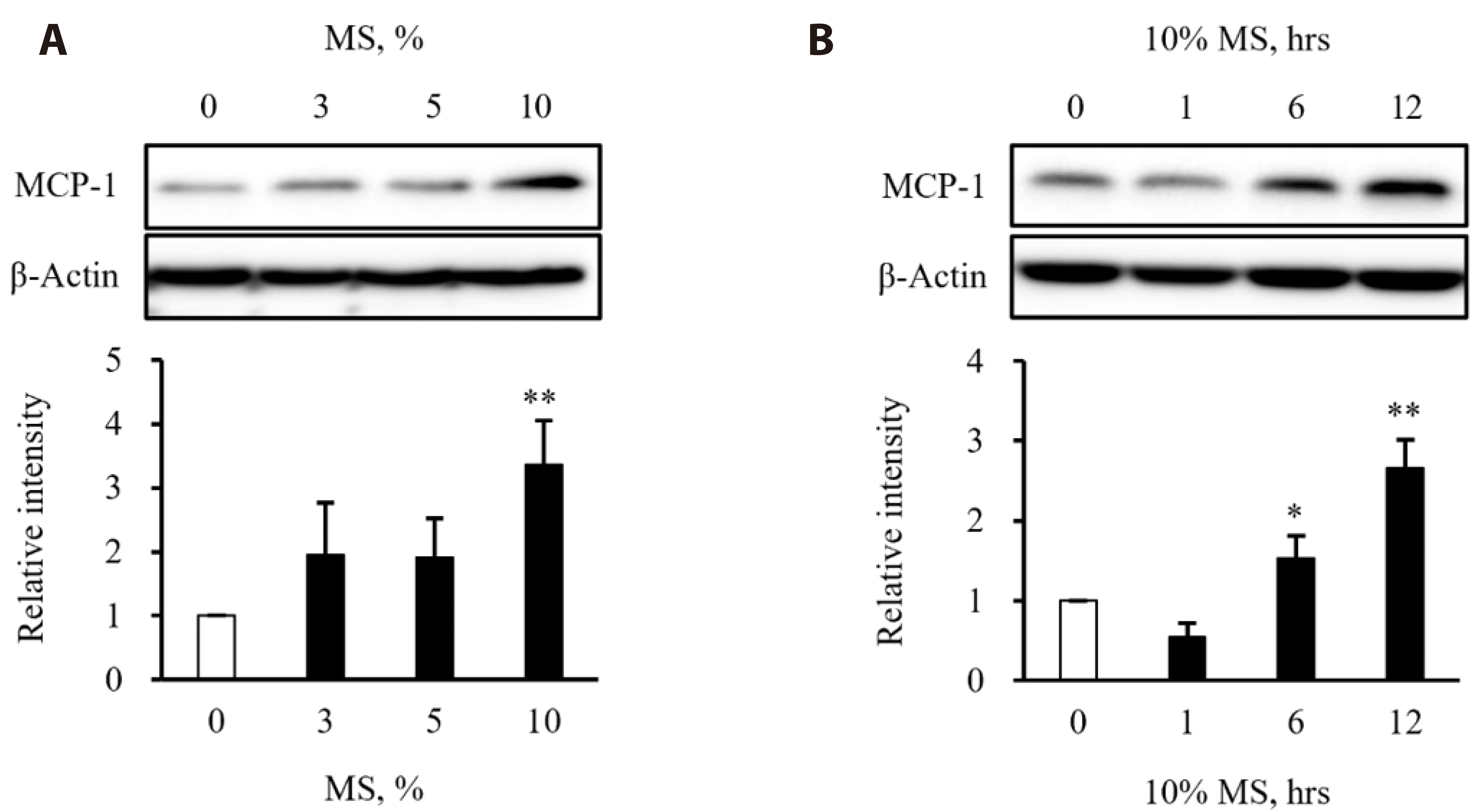
Fig. 2
High mobility group box 1 (HMGB1) release and its role on monocyte chemoattractant protein 1 (MCP-1) expression in vascular smooth muscle cells (VSMCs) stimulated with mechanical stretch (MS).
(A) Force- and time-dependent effects of MS on HMGB1 release in VSMCs. Rat VSMCs were stimulated with 3% and 10% MS for 0–12 h, and then HMGB1 released into cell culture media was measured by ELISA. The concentration of HMGB1 released into culture media was quantified and expressed as the means ± SEM of 4 independent experiments **p < 0.01 vs. corresponding value in the 3% MS group. (B) Role of HMGB1 on MCP-1 expression in VSMCs stimulated with MS. Rat VSMCs were pretreated with an inhibitor for HMGB1 (glycyrrhizin, 0–10 nM) for 24 h, and the cells were then stimulated with 10% MS for 12 h. The expression of the MCP-1 protein was determined by Western blot. β-Actin was used as an internal control. The blots are representative of 4 independent experiments. Relative intensities to β-actin were quantified and expressed as the means ± SEM of 4 independent experiments. **p < 0.01 vs. control. ##p < 0.01 vs. vehicle.
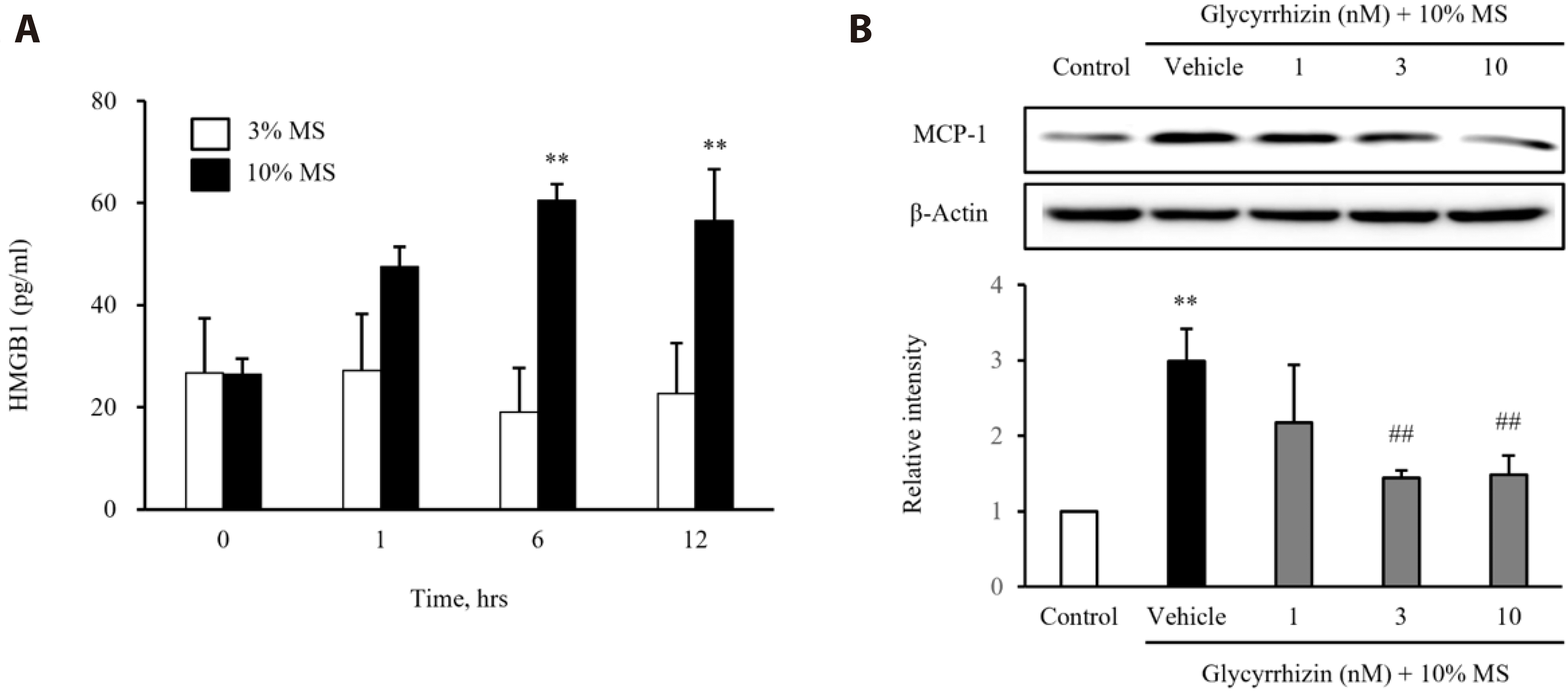
Fig. 3
Effects of mechanical stretch (MS) on PDGFR expression in vascular smooth muscle cells (VSMCs).
The cultured rat VSMCs were stimulated with MS (3 and 10%) for 6 h, and then the expression levels of PDGFR-α and PDGFR-β were determined by Western blot. β-Actin was used as an internal control. The blots are representative of 5 independent experiments. Relative intensities to β-actin were quantified and expressed as the means ± SEM of 5 independent experiments. **p < 0.01 vs. corresponding value in control.
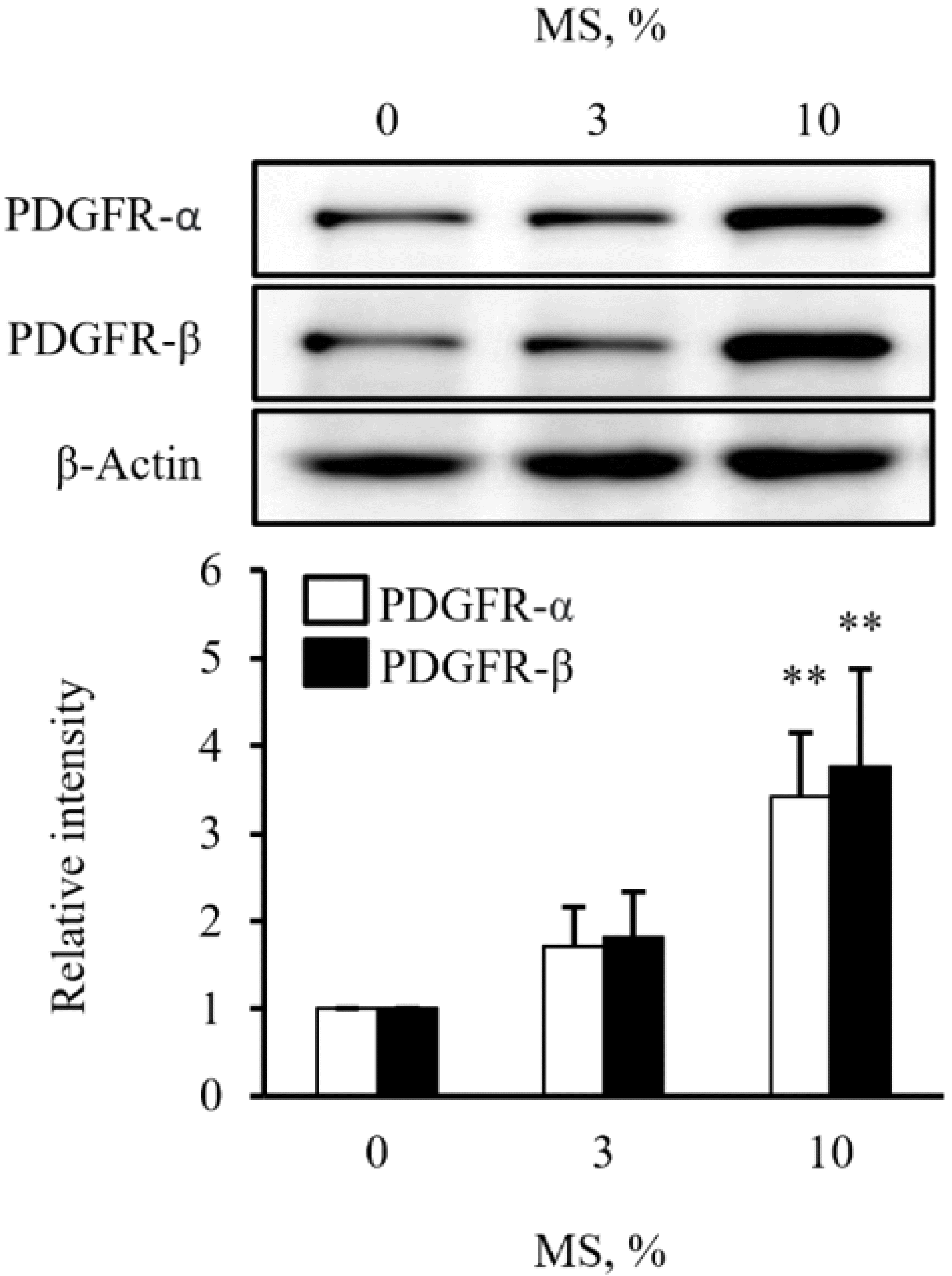
Fig. 4
Individual roles of the PDGFR isoforms on high mobility group box 1 (HMGB1) release in mechanical stretch (MS)-stimulated vascular smooth muscle cells (VSMCs).
The cultured VSMCs were transfected with siRNAs (200 nM) for PDGFR-α (A) or PDGFR-β (B) for 24 h, and then stimulated with 10% MS for 6 h. The expression levels of PDGFR-α and PDGFR-β isoforms were determined by Western blotting using β-actin as an internal control. Relative intensities were quantified and expressed as the means ± SEM of 4 independent experiments. **p < 0.01 vs. control. ##p < 0.01 vs. corresponding value in negative control. (C, D) VSMCs transfected with PDGFR-α or PDGFR- β siRNA (200 nM) for 24 h were stimulated with 10% MS for 6 h. The HMGB1 released in the culture media were quantified by ELISA. The concentration of HMGB1 were quantified and expressed as the means ± SEM of 4 independent experiments. **p < 0.01 vs. control. ##p < 0.01 vs. corresponding value in negative control.
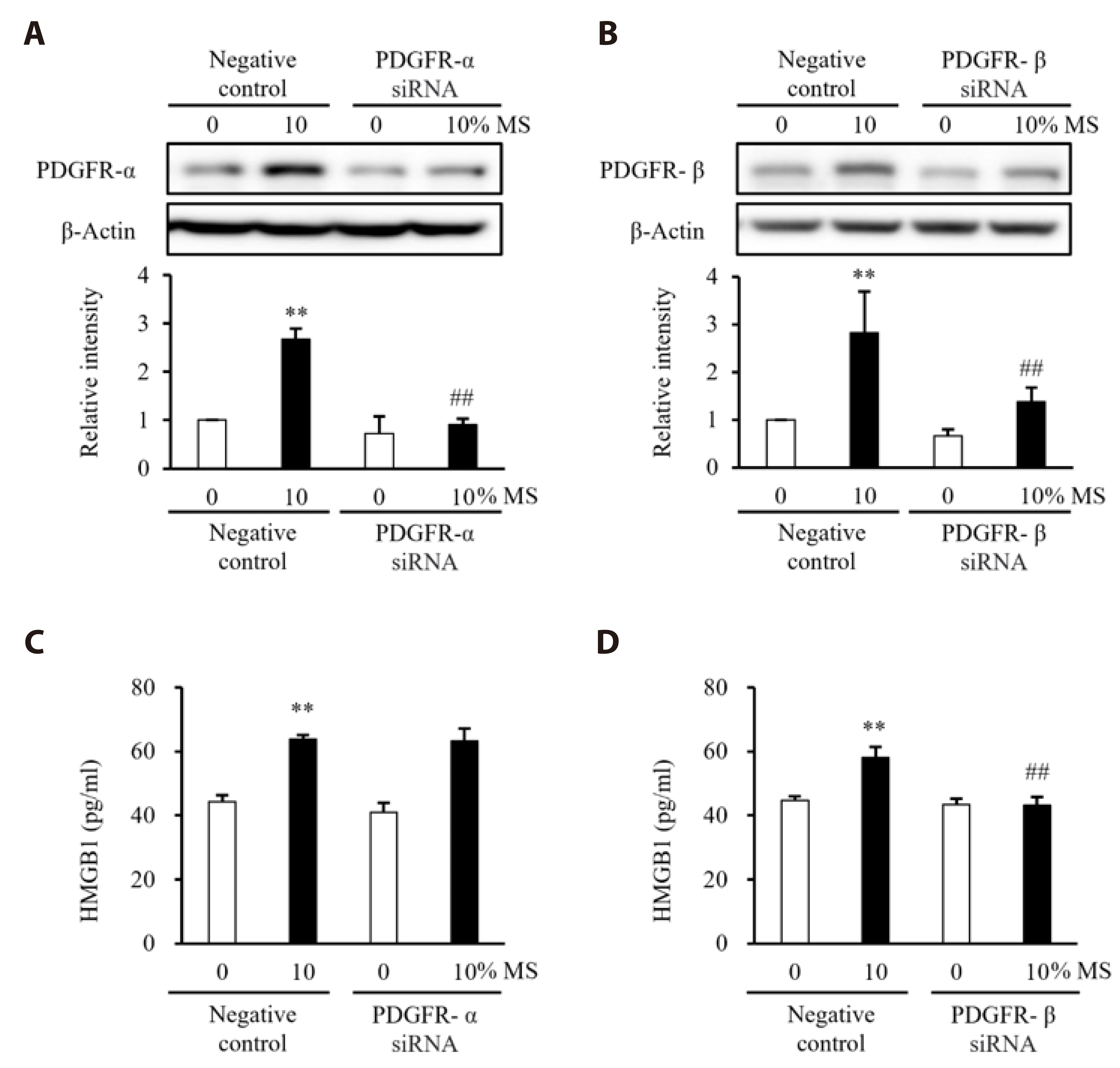
Fig. 5
Role of PDGFR-
β signaling on monocyte chemoattractant protein 1 (MCP-1) expression in vascular smooth muscle cells (VSMCs) stressed with mechanical stretch (MS). The cultured VSMCs were transfected with PDGFR-β siRNA (200 nM) for 24 h, and then stimulated by 10% MS for 6 h. The expression levels of PDGFR-β and MCP-1 were determined by Western blotting using β-actin as an internal control. The blots are representative of 4 independent experiments (A). Relative intensities of PDGFR-β (B) and MCP-1 (C) to β-actin were quantified and expressed as the means ± SEM of 4 independent experiments. **p < 0.01 vs. control. ##p < 0.01 vs. corresponding value in negative control. (D) MCP-1 expression in 10% MS-stimulated cells was compared with that in control cells, and the relative increase rate was quantified. Data were expressed as the means ± SEM of 4 independent experiments. **p < 0.01 vs. negative control.
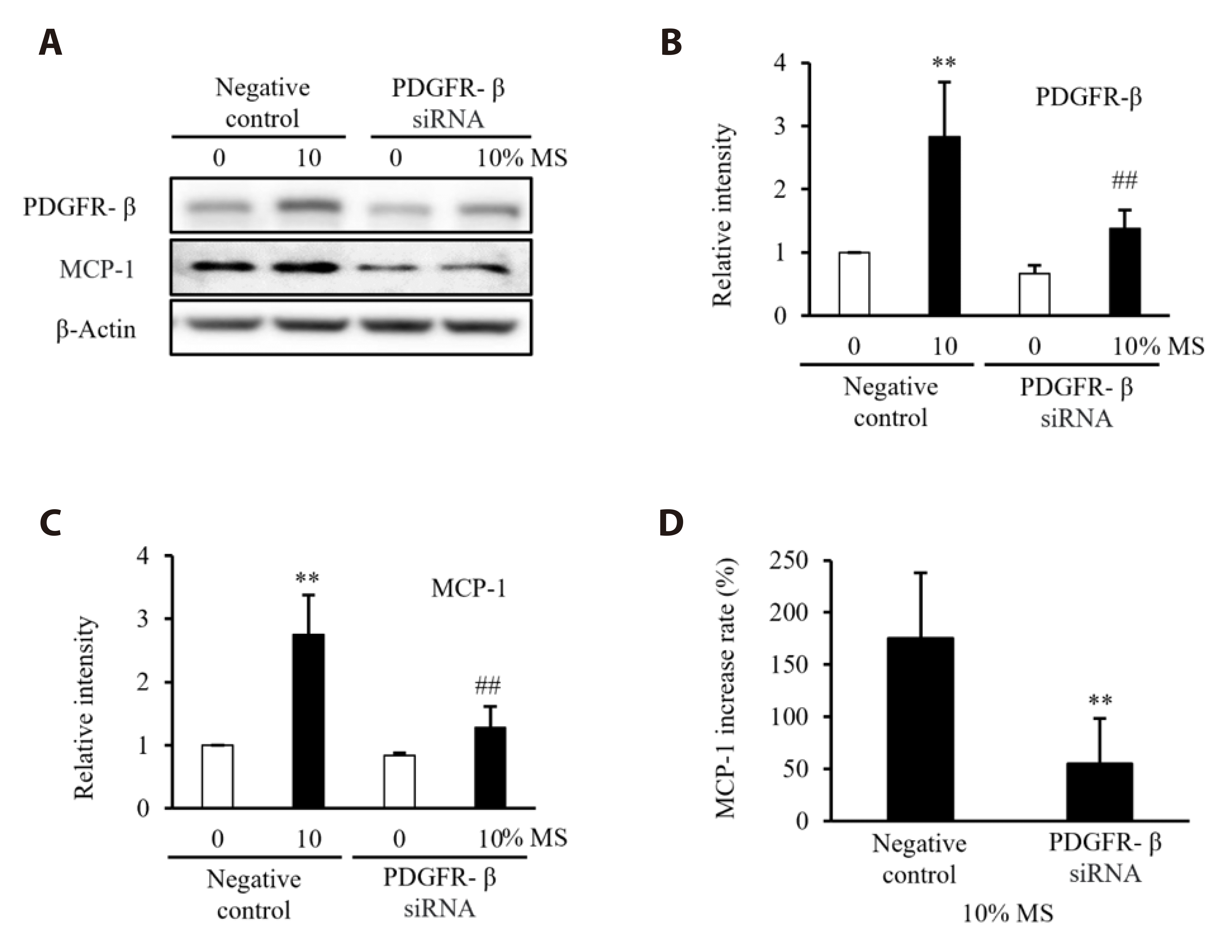




 PDF
PDF Citation
Citation Print
Print


 XML Download
XML Download